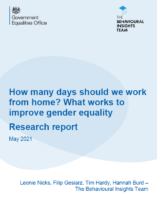Key findings
- In a trial we ran with @DefenceES, we found that a one-size-fits-all approach to #remoteworking could create a gender gap in wfh days. Funded by @GEOgovuk Tweet
- How should employers address #flexibleworking as the UK reopens? We found that setting any kind of expectation on #WFH days could create a gender gap. Tweet
Today we launch a report detailing a randomised controlled trial (RCT) we ran with Defence Equipment & Support (DE&S). The trial set out to evaluate the impact of setting different expectations for how much employees should work from home. DE&S is a public sector organisation with 11,500 employees (66% men) and was heavily office-based prior to the pandemic. The RCT tested how different messages would influence intentions and preferences for working from home (n=3,852).
Two intervention messages were tested against a control message:
- Neutral (control): Your responses will help us to plan reopening the offices.
- Default norm: We expect employees to continue to primarily work from home.
- Low anchor: We expect employees to work from home on average 2 days per week.
Both messages communicated and set an organisational expectation. Neither of the two messages had a significant impact on average intentions or preferences across all employees. However, women reduced their intentions to work from home by around a quarter of a day per week (8%) in response to the intervention messages, while men’s intentions did not change.
These results suggest the communication of an organisation’s working from home policy could result in gender unequal uptake. We recommend that organisations avoid prescriptive messages that specify how much employees are expected to split their time between working onsite and from home.








